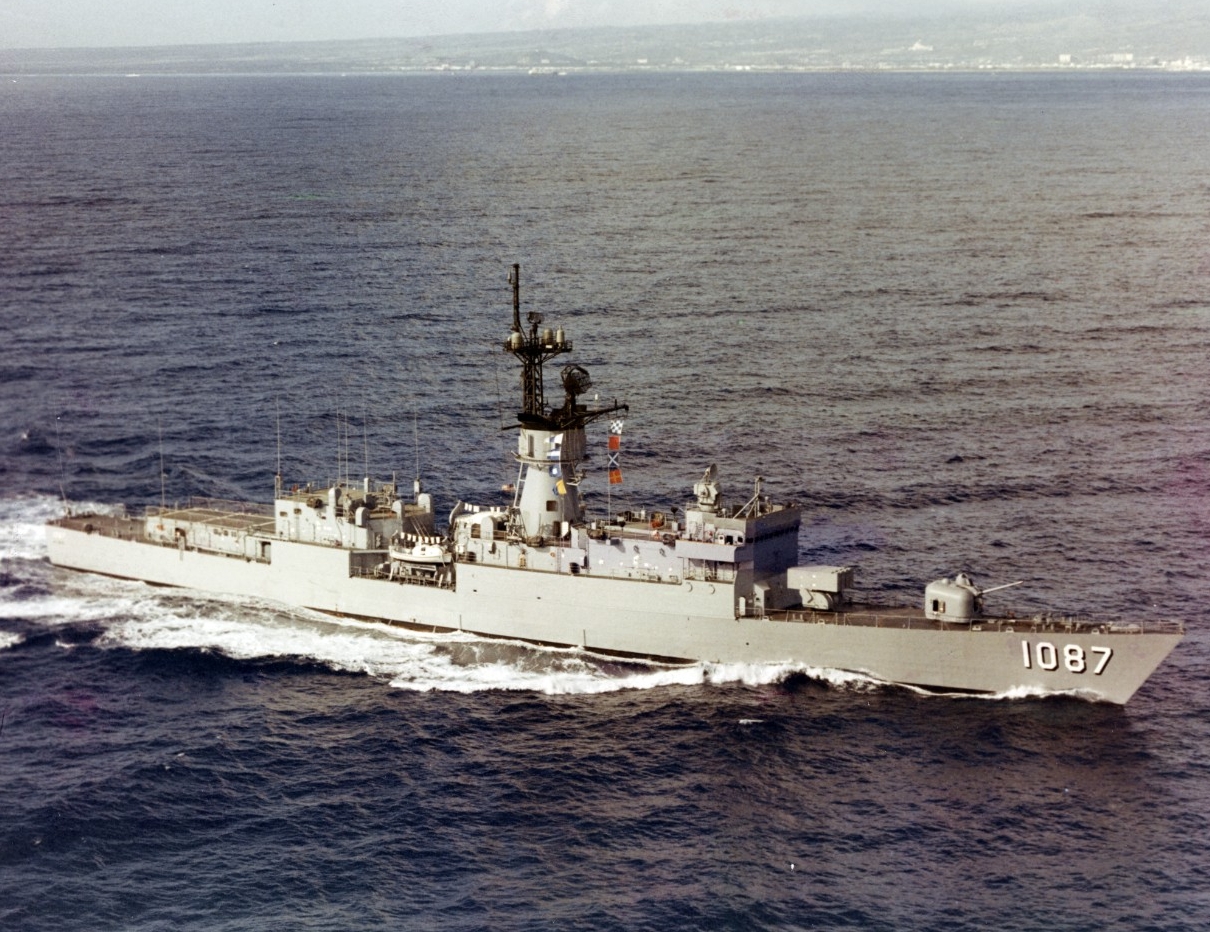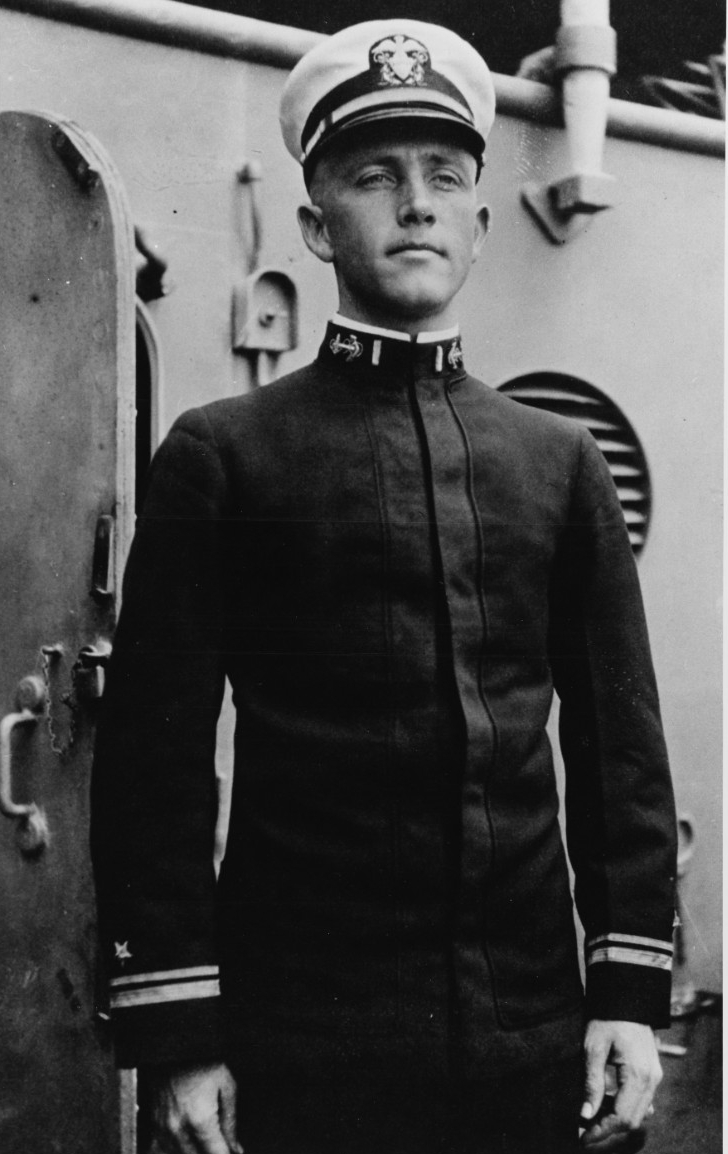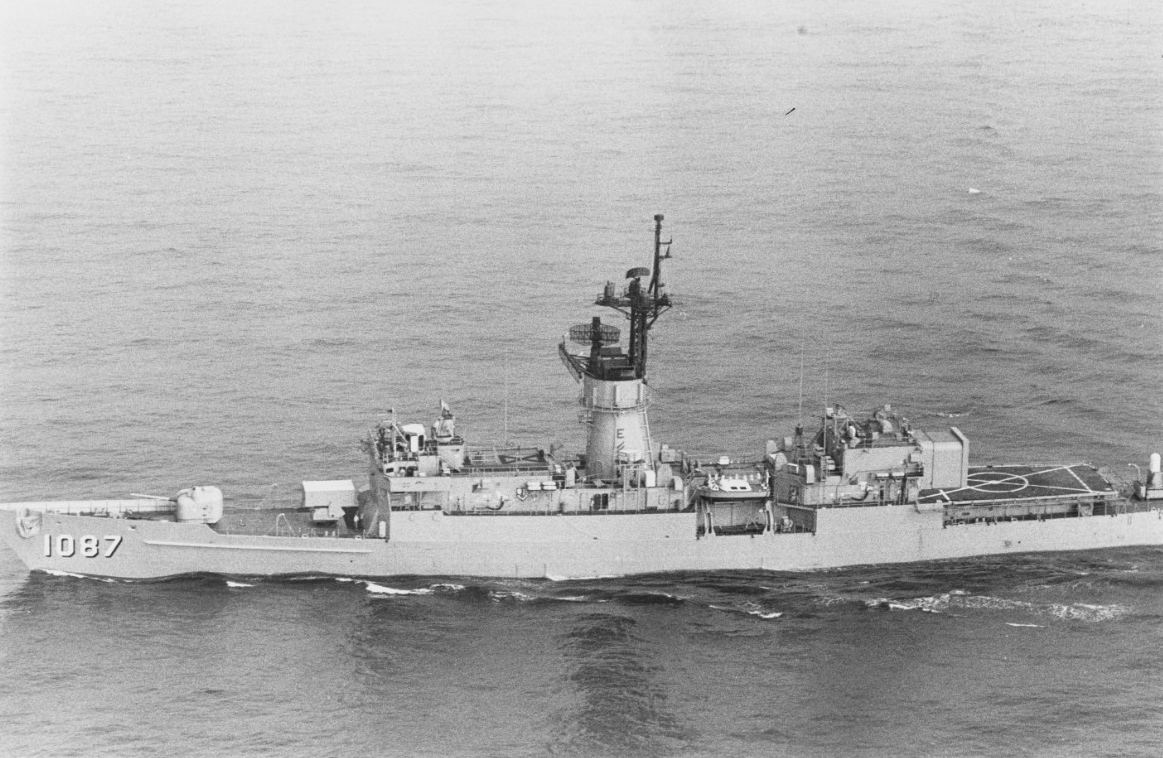USS Kirk (DE/FF-1087)
1972–1993
The first U.S. naval vessel named for Admiral Alan Goodrich Kirk, born 30 October 1888 in Philadelphia, Pennsylvania, to William and Harriet [Goodrich] Kirk. Graduating from the U.S. Naval Academy on 4 June 1909, Ensign Kirk became an ordnance expert during World War I, and was later Director of Naval Intelligence in 1941. At the outbreak of World War II, Adm. Kirk served as Chief of Staff to Admiral Harold R. Stark, before assuming command of the Atlantic Amphibious Force in February 1943. In October 1943, Adm. Kirk commanded the Naval Task Force, forming the American half of the combined invasion force of Normandy. Directing and planning the execution of the naval phases of Normandy as Commander of U.S. Naval Forces France (1944-1945), Adm. Kirk ensured the steady flow of logistics to ground forces fighting inland. After the war, he served as Ambassador to Belgium (1946-1949), and Ambassador to the Soviet Union (1949-1951). Later, he served as Ambassador to Nationalist China in Taiwan (appointed 3 May 1962), but resigned a month later due to ill health. Adm. Kirk died on 15 October 1963.
(DE/FF-1087); displacement: 4,200 tons; length 415'; beam 46' 9"; draft 24' 9"; speed 27 knots; complement 244; armament 1 5-inch Mk 42; 1 Mk 16 ASROC launcher, 2 Mk 32 torpedo tubes/Mk 46 torpedoes, 1 Mk 29 NATO Sea Sparrow missiles, Harpoon missiles from modified ASROC launcher; class Knox)
The destroyer escort Kirk was laid down on 4 December 1970, at Westwego, Louisiana, by the Avondale Shipyards, Inc.; launched on 25 September 1971 and sponsored by Mrs. Lydia C. Kirk, Adm. Kirk’s wife; and commissioned on 9 September 1972, Cmdr. James P. Kvederis in command.
Kirk steamed to Vancouver, British Columbia, on her maiden voyage in November 1972. On 23 November 1973, Kirk, in company with Kitty Hawk (CV-63), made way from San Diego on her first Western Pacific (WestPac) deployment. Kirk escorted Kitty Hawk for 60 days of operations in the Indian Ocean before returning to San Diego on 1 June 1974.
During her second WestPac deployment, as Saigon fell to North Vietnamese military forces, Kirk participated in Operations EAGLE PULL and FREQUENT WIND (25 March-7 May 1975), evacuating refugees from Cambodia and South Vietnam. During Operation NEW LIFE, Kirk rendezvoused with units of the Vietnamese Navy near Con Son Island and assisted in transporting refugees to Subic Bay, Philippine Islands. Thirteen UH-1 Huey helicopters landed on Kirk’s flight deck within a 24-hour period laden with additional refugees. Hundreds of persons were sheltered and fed before transferring to larger Navy transports. Kirk received the Armed Forces Expeditionary Medal for her service off Vietnam. On 30 June, Kirk was reclassified as a frigate (FF 1087).
After changing homeports from San Diego to Yokosuka, Japan, Kirk got underway from Southern California for the Western Pacific on 17 July 1976. Arriving in August, Kirk immediately deployed to patrol Korean waters after an incident along the DMZ on the 21st. Steaming into Typhoon Carol on her way home to Yokosuka on 6 September, Kirk began much needed upkeep in October.
Kirk began a major overhaul in January 1977, before moving on 9 January to dry dock 5 for the next seven months. In August, Kirk received the Meritorious Unit Citation (MUC) for services in Operation FREQUENT WIND and the evacuation of Vietnamese refugees. After spending the first few months of 1978 undergoing post-overhaul training and inspections at Subic Bay, Kirk got underway for a three-month deployment to the Indian Ocean. Kirk became the first U.S. Navy ship to visit Taichung, Taiwan (25-27 August), and got underway for participation in READEX 1-79 with Task Group 77.4 and Battle Group Midway (CV-41) from 21 September-2 October.
In September 1979, Kirk had a Harpoon missile system and an AN/SQR-18A (TACTAS) sonar system installed. In port at Yokosuka, she remained in dry dock for work on her sonar dome (1-19 January 1980). She then conducted antisubmarine warfare (ASW) operations in the South China Sea (3-12 February). In early July, Kirk steamed with Task Group 70.1 for a four-month deployment to the Indian Ocean (14 July-26 November).
Departing Yokosuka on 23 February 1981, Kirk got underway with carrier Midway for her fourth deployment (and second in a year) to the Indian Ocean. The frigate steamed to the northern Arabian Sea to conduct Exercise INDO GONZO 81-3 (14-18 April) alongside Australian naval forces. She returned to Yokosuka on 5 June, before steaming out for major Seventh Fleet Exercise MULTIPLEX 81-4 (9-14 July). Kirk received orders to get underway and rendezvous with TG 70.1 in response to a possible North Korean threat to South Korea, but the threat did not materialize and the frigate returned to her homeport (19-20 December).
On 18 January 1982, Kirk entered dry dock to begin her baseline overhaul, which lasted until 15 November. After completion of her overhaul, she made way to Subic Bay to begin training exercises and an ammunition on-load at Moor Nabasan Wharf (15 December), before returning to Yokosuka for holiday stand down.
Kirk got underway to participate in Exercise TEAM SPIRIT 83 at Chinhae, Korea (18 March 1983). After refresher training (18 April), she joined Battle Group Coral Sea (CV-43) to assist in ASW exercises. On 21 November, Kirk rescued 23 survivors from the 25-person crew of Taiwanese merchant ship Dai Lung, after the vessel took on water in rough seas during Typhoon Orchid and sank in the South China Sea.
In January 1984, Kirk departed Subic Bay for work-ups in the South China Sea. She joined Battle Group Alpha (Midway) in the North Arabian Sea (16 April), before crossing the Equator on the 19th. After inducting polliwogs into the Mysteries of the Deep, the new shellbacks became certified members of King Neptune’s Court. During the cruise, Kirk spent 110 consecutive days at sea, conducting operations with the Royal Navy, Royal Omani Air Force, Royal Malaysian Navy, and French Navy. She visited only two ports, Singapore (24-28 April) and Pattaya, Thailand (1-7 May), before returning to Yokosuka in late June.
After conducting surveillance operations of the Russian Novorossiysk Battle Group (4-18 April 1985), Kirk participated in an anti-submarine rocket (ASROC) firing exercise the following month. While getting underway from Subic Bay on 24 June, a rogue wave struck the frigate’s bow, injuring 7 personnel and requiring Kirk to return to port for medical assistance. Transiting through the Strait of Malacca to the North Arabian Sea in July 1985, Kirk operated with Battle Group Alpha for the next several months. On 13 July, Kirk recovered Lt. Cmdr. J. M. Twiss, a downed LTV A-7 Corsair II pilot from Midway. Six days later, she conducted a medical evacuation of a seriously ill Burmese seaman from merchant vessel Tomoe 305. The frigate also participated in ASWEX 85-1J, a joint ASW exercise with the Japanese navy (8-11 December).
Kirk began the first few months of 1986 conducting upkeep prior to weapons and ammunition on-loads and sea trials in April. After conducting a FIREX 1 exercise in July, the frigate rescued 11 Vietnamese refugees from an adrift fishing boat in the South China Sea (15 August). The frigate operated off Japan for the rest of the year in various training cycles.
While making a port visit to the Sultanate of Brunei, Kirk became only the third U.S. warship to visit the small nation on the island of Borneo since 1845 (2-6 July 1987). While anchored in Yokosuka through the beginning of 1988, Kirk completed sea trials before getting underway for TEAM SPIRIT 88 (25-29 March). Just before Typhoon Vanessa struck the South China Sea region in the first week of July, the frigate rescued nine Vietnamese refugees approximately 300 nautical miles east of Ho Chi Minh City (21 June).
Changing operational command to the Third Fleet (6 August) while underway for the mainland of the United States, Kirk made port visits to Honolulu (12-17 August) and Long Beach (18-24 August), before arriving at San Francisco (22-25 September). A day later, she departed to participate in law enforcement operations with embarked U.S. Coast Guard detachments. Kirk also took part in San Francisco’s Fleet Week celebrations (15-19 October) before returning to her new homeport at Long Beach.
The frigate participated in 1989’s first Eastern Pacific ASW exercise (ASWOP 89-1) from 26 February-6 March. Steaming north to San Francisco and Seattle, Wash., Kirk operated with the Royal Canadian Navy and various U.S. naval warships in ASWOP 89-2 (25 May-5 June). She ended the year with an overhaul period at Todd Shipyards, Seattle (6 July 1989-2 March 1990).
After conducting sea trials upon her departure from Todd Shipyards (3-5 March 1990), Kirk steamed to Treasure Island in the San Francisco Bay before arriving to her homeport at Long Beach for upkeep. Recurrent equipment malfunctions in October caused repeated delays in her deployment schedule. Finally, on 3 December, Kirk got underway from Long Beach en route to Panama. On the way, she stopped in Guatemala for fuel, and became the first U.S. naval warship to refuel at Puerto Quetzal. The frigate spent Christmas in Panama, and New Year’s Day 1991 underway off Guatemala, conducting surface and air surveillance for narcotics trafficking groups.
Kirk conducted counter-narcotics operations off South America (1-11 January 1991), before a short port visit to Puerto Quetzal (12-14 January). After a month in Long Beach for upkeep, the frigate acted as plane guard for aircraft carrier Abraham Lincoln (CVN-72) from 25-26 February. Later, she acted as plane guard for aircraft carrier Independence (CV-62) from 28 May-4 June, and made port visits to Anchorage, Alaska (27 June-3 July), Seattle (3-7 July), and Esquimalt, B.C. (6-9 August), before steaming back to Long Beach for another upkeep period. Making way to Hawaii (23-28 August), Kirk made a port visit at Pearl Harbor (28-29 August) before returning home to conduct sea trials (12-13 December).
Spending the first four months of the year in port at Long Beach, Kirk got underway to participate in COMPUTEX 92-4E off the coast of Southern California (18-22 May 1992). The frigate prepared for a WestPac deployment, getting underway with Battle Group Ranger (CV-61) for Yokosuka (1-17 August). After a port visit to Pusan, South Korea (26-29 August), a scheduled stop at Singapore was cancelled due to increased tensions in the Middle East. Steaming directly towards the Arabian Gulf, the frigate narrowly avoided Typhoons Polly and Omar. However, storm damage to her sea-surface search radar required a brief repair stop at Bahrain (15 September), after which Kirk joined with Kinkaid (DD-965) at Al Jubail, Saudi Arabia, for Exercise NAUTICAL SWIMMER (19-23 September) with the Royal Saudi Navy.
After participating in Exercise SAQR AL BAHR (5-6 October) with guided missile frigate Taylor (FFG-50), Kirk began two weeks of at-sea operations in the Gulf of Oman and Arabian Gulf. The frigate operated with Britain’s HMS Invincible Battle Group, in the midst of a round-the-world cruise. Kirk then became a last-minute addition to Exercise EAGER SENTRY 93-1 (2-3 November), joining Paul F. Foster (DD-964) off Kuwait. After a five-day port visit to Muscat, Oman, Kirk steamed to the northern coast of Africa and back to the Arabian Gulf (15-20 November). After a brief maintenance period in Bahrain (5-10 December), she transited the Strait of Hormuz en route to Geraldton, Australia. She returned to Long Beach in early 1993.
Kirk was decommissioned on 6 August 1993.
Leased to the Taiwanese Navy, she was renamed ROCS Fong Yang (FF-934).
Struck from the Naval Vessel Register on 11 January 1995, ex-Kirk was sold to Taiwan on 29 September 1999.
Commanding Officers Dates Assumed Command
Cmdr. James P. Kvederis |
9 September 1972 |
Cmdr. Harold E. Burgess, Jr. |
17 August 1973 |
Cmdr. Paul H. Jacobs |
29 August 1974 |
Cmdr. James H. Langen |
10 July 1976 |
Cmdr. Fletcher J. Barnes III |
12 August 1977 |
Cmdr. Richard C. Davis |
7 September 1979 |
Cmdr. Edmund L. Pratt, Jr. |
10 December 1982 |
Cmdr. James F. Giblin, Jr. |
4 January 1984 |
Cmdr. Stanton V. Mahoney, Jr. |
23 June 1985 |
Cmdr. Emil R. Diamond, Jr. |
3 August 1985 |
Cmdr. Larry W. Darling |
5 August 1987 |
Cmdr. Thomas M. Keithly |
30 September 1989 |
Cmdr. John B. Bell |
1 November 1991 |
Guy J. Nasuti
22 November 2019





